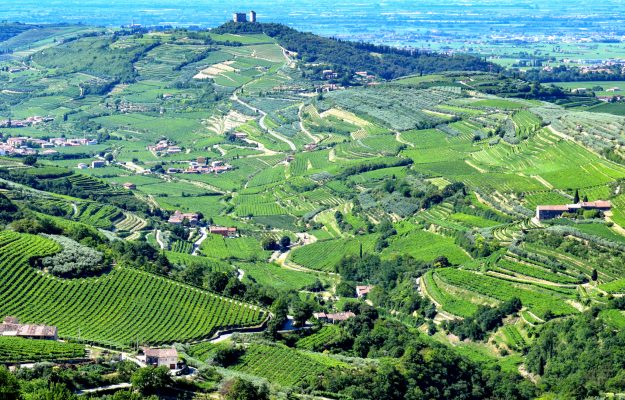Suffering overall, but in all the most important markets stronger than average, with some even positive signs even in countries in negative territory. This is the picture of Italian wine exports in 2020 of the pandemic, which tells of an ability to resist and adapt strongly to the impact of Covid, thanks above all to a shift of sales from the horeca channel, substantially paralyzed everywhere, to large-scale distribution. Although it should be stressed once again, this is an overall picture that does not apply to all companies, with some more structured, agile, and with already diversified markets that have held up better, and others that have suffered much more. This is true for Italy as a whole, and for one of its most important territories, Valpolicella, in a scenario, recounted today at the “Valpolicella Annual Conference”, promoted by the Consorzio Vini Valpolicella, that was totally digital.
Export figures for 2020, elaborated by Denis Pantini of Nomisma Wine Monitor, are clear: in the USA, where imports collapsed by -11.1%, Italy limited the damage to -3.3%; in the UK, where imports were down by -12.4%, Italy was down by -4%; in Germany, where exports were down by -4.5%, Italian wines grew by 1.1%; in Switzerland, where imports were substantially stable, they were up by +6.1%; in Sweden, where exports were up by +2.5%, they were up by +3.9%. This is just to stop at the most important markets, with Canada as the only discordant note, where, compared to an overall -0.9%, Italy left 3.1% on the ground. In short, an overall endurance of exports, which will be fundamental also in the future. But, as WineNews surveys and interviews have repeatedly underlined, at least in the near future, the role of large-scale distribution, wine shops, e-commerce, direct sales, wine clubs will grow, while waiting for the recovery of the “out of home” sector, with catering and tourism at a standstill, but with changes in distribution destined to become structural. And it must be well understood and analyzed, because if volumes have more or less held up, the same is not true for values, as Cristian Marchesini, president of the Valpolicella Consortium (a wine district with a turnover of 600 million euros per year) points out: “In 2020 we produced 64 million bottles ready for sale. This is a good result in line with the previous year's figures, despite the fact that the average price has dropped a bit. Considering everything that has happened, we could say that it is half a victory, but we don't: too many small wine companies have paid for the gap in catering, and have not been able to expand sales to other distribution channels”.
Under the lens, the growth and evolution of demand in the large-scale retail trade in Italy and abroad, as recorded by US-based Wilson Daniels, a leading company in the import/distribution of high-end products with 45 European luxury brands in its portfolio. “In US retail - said the brand manager for Italy, Alessandro Boga - we are seeing a strong increase in sales of high-end wines. In 2020 the “luxury” (over 20 dollars per bottle), ultra and super premium (from 10 to 20 dollars) segments grew in value in the large-scale retail trade by 26% and 23% respectively and today account for more than 50% of the entire wine turnover. Retail is up, but out-of-home sales are down. The data from the Wilson Daniels portfolio reflect the substitution effect of consumption methods on the world's leading market for Amarone and Italian wine, with the on-trade registering a drop in its market share from 57% to 35% in one year and the off-trade leading the way (from 43% to 65%), with Valpolicella wines up 70%. In the background, the boom of online sales on the wine.com portal, which increased by 142%, and the doubling of the market in the wine club channel”.
Italian large-scale distribution is also growing, as pointed out by Francesco Scarcelli, Head of Spirits at Coop Italia: “the increase in wine sales in 2020 was important, around 5.5%, with a slight increase in prices (+1.5%) also due to fewer promotions. We are witnessing different policies by brands that until recently did not approach large-scale distribution, whereas today they consider it an interesting channel for their high-end products. Certainly, the role of all large-scale distribution in wine will grow: in 2019 the channel moved 64% of wine sold, we are waiting for the final 2020 figure which will certainly be significantly higher. But we all have to adapt: the Italian one is a mature market, the consumer, especially in large-scale distribution, is looking for quality at fair prices, and the more informed consumers are the more they can give real value to what they buy. We, as Coop, are already experimenting, we have isolated table wines from the “wine shop” with more qualified personnel ad hoc, also approaching food to make pairings. There will be more and more a national assortment to cover all the most important appellations, integrated with every territory with an increasingly local offer to give vent to those who suffer in the other channels. Clearly, it is not easy: there are already hundreds of references on the shelf, and a new, different relationship must be created between distribution and production”.
In any case, it is now a certainty that multichannel distribution will be increasingly important, as Denis Pantini underlined: “Italy suffers less than its main competitors precisely because of its greater diversification of wine distribution in the world. A component that has also favored Valpolicella wines, particularly abroad. In Italy, e-commerce started quietly, but last year it doubled its turnover, today at 200 million euros. It is a structural phenomenon and no longer dictated by the emergency, but - it should be remembered - it is worth 7% of the wine turnover of large-scale distribution”.
The online combined with the “in store” experience, made of wine but also gastronomy, is the path traced by Signorvino, the great Italian wine chain (which, just yesterday, opened in Fidenza, in Parma Italian Capital of Culture 2020 + 2021 and Unesco Creative City of Gastronomy since 2015, its 21st Italian store), “and this has allowed us to suffer fewer losses than the traditional horeca. If the restaurant industry as a whole accuses losses of -60%, we have seen a drop of -40% in a year in which the out of home has long been at a standstill or with severe limitation” - said brand manager Luca Pizzighella. Who, however, also emphasizes positive signs from which to restart. “the pandemic has accelerated the trend of higher spending per bottle, a process of premiumization generated by the greater purchasing power determined by the closure of restaurants. The Valpolicella appellation is one of Signorvino's leading products, accounting for 35% of red wine spending and with Amarone accounting for 52% of purchases of products from the territory, followed by Ripasso (38%). Finally, the demand for the King of Valpolicella prevails over the other 2 great Italian red appellations: Amarone represents 9% of the volumes sold, against 4% for Barolo and 3% for Brunello di Montalcino”.
Emphasizing the boom in e-commerce was Paolo Zanetti, founder of Callmewine, which, in late 2020, saw the Pesenti family’s Italmobiliare invest 13 million euros to acquire a majority stake in the company, of which it now owns 60%, and which closed the year with a doubling of turnover, to 12 million euros. “The approach to e-commerce by so many for the first time, and the increased use of this channel by others, will leave a structural change in this channel. That, in my opinion, by giving the possibility to everyone, everywhere, to taste wines of every territory, in the long run will reward quality, thanks to the comparison between different wines. An important appellation such as Valpolicella has also benefited from the growth. The increase in volume has been of 84%, thanks in particular to Valpolicella and Amarone. In terms of value, DOCG sales represent 55% of the total, with Ripasso at 28%, Valpolicella (classic and superior) at 17% and Recioto at 1%”.
But in addition to communication channels and strategies, Italian wineries will also have to rethink their approach to the consumer, said Roberto Burro, professor of Psychology at the University of Verona. “The client is increasingly asking to be recognized and known. The approach must change: from “tell me what wine you drink and I’ll tell you who you are”, to “tell me who you are and I’ll tell you what wine to drink”. But a change of language is also needed, because today the world of wine speaks what can be defined as a language that most of the consumers, not only wine lovers, for the most part do not understand. Today we can say that 2/3 of what is communicated by wine companies is either not understood, or it risks to be even productive. Let’s look at the descriptions of wines in the label: 40% is made of olfactory descriptors, 40% of taste descriptors, 16% of sight descriptors, and only 4% talk about the globality of that wine”.
Copyright © 2000/2025
Contatti: info@winenews.it
Seguici anche su Twitter: @WineNewsIt
Seguici anche su Facebook: @winenewsit
Questo articolo è tratto dall'archivio di WineNews - Tutti i diritti riservati - Copyright © 2000/2025









































































































































































































